What is the difference between the full-step, the half-step, and the micro-drive?
In addition to the motor body, the driving method has a significant impact on the stepper motor's performance. Various types of driving methods are available for stepping motors, including full-step, half-step, and micro-step. What do they mean? The following explanation will assist you. Stepper motor drives can be operated in three basic modes: full-step, half-step, and micro-step.  Below is the current vector segmentation diagram:
Below is the current vector segmentation diagram: 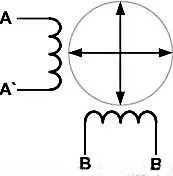 Below is the I vs T diagram:
Below is the I vs T diagram: 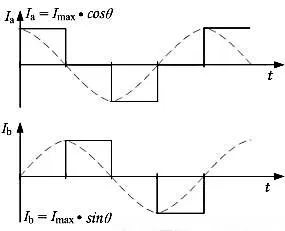 A full-step vector divides a circle into four equal parts, and the current waveform is rough. As a result of this driving method, the motor will shake at low speeds and there will be a lot of noise. As a consequence of the full-step drive's relatively simple design, it is easier to control the manufacturing costs of the drive.
A full-step vector divides a circle into four equal parts, and the current waveform is rough. As a result of this driving method, the motor will shake at low speeds and there will be a lot of noise. As a consequence of the full-step drive's relatively simple design, it is easier to control the manufacturing costs of the drive. 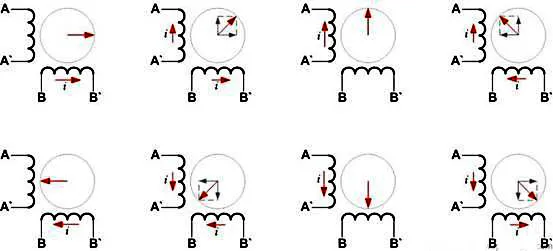 In comparison with the full-step driving method, the half-step driving method is relatively more complex. Both phases may need to be energized simultaneously, and the energizing current should be 2/2 that of the single-phase energizing current. Naturally, it is also possible to pass a current equal to the single-phase current directly. As a result, the torque generated by the motor during rotation is not constant, but it does have the advantage of simplifying the driving circuit or software. The driving phase sequence of the half-step driving method is as follows: BB'→BB'& A'A→A'A→B'B & A'A→B'B→B'B & AA'→AA'→ AA'& BB'. The motor is energized according to the above phase sequence, and the resulting current vector divides a circle into eight segments. The following is the current vector segmentation diagram:
In comparison with the full-step driving method, the half-step driving method is relatively more complex. Both phases may need to be energized simultaneously, and the energizing current should be 2/2 that of the single-phase energizing current. Naturally, it is also possible to pass a current equal to the single-phase current directly. As a result, the torque generated by the motor during rotation is not constant, but it does have the advantage of simplifying the driving circuit or software. The driving phase sequence of the half-step driving method is as follows: BB'→BB'& A'A→A'A→B'B & A'A→B'B→B'B & AA'→AA'→ AA'& BB'. The motor is energized according to the above phase sequence, and the resulting current vector divides a circle into eight segments. The following is the current vector segmentation diagram: 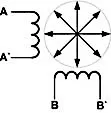 Below is the I vs T diagram:
Below is the I vs T diagram: 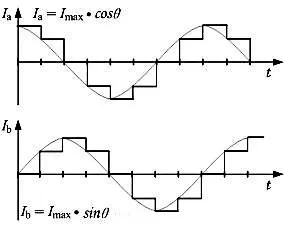 According to the above figure, the half-step drive's current waveform is relatively smooth. The motor's step angle resolution is doubled when compared with the whole step drive, and it runs more smoothly and quietly as well.
According to the above figure, the half-step drive's current waveform is relatively smooth. The motor's step angle resolution is doubled when compared with the whole step drive, and it runs more smoothly and quietly as well. 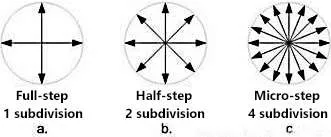 Figure c is a segmentation diagram of the 4 subdivisions drive. The whole-step and half-step drives are also subdivision driven, and their relationship is similar to that between a square and a rectangle.
Figure c is a segmentation diagram of the 4 subdivisions drive. The whole-step and half-step drives are also subdivision driven, and their relationship is similar to that between a square and a rectangle. 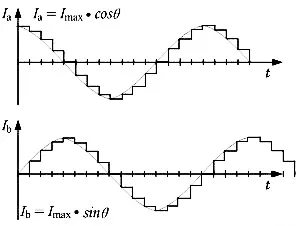 The figure above illustrates the current diagram of four subdivisions. According to the figure, the current curve of each phase is more delicate than the current curve of the half-step drive, which is similar to a sine wave. The subdivision drive method is an extremely effective way to reduce vibration, but there are the following points to note: ● In general, the subdivision drive performs better at low speeds. When the input frequency is too high, the subdivision waveform will not be able to produce the desired current waveform, thereby reducing the accuracy of the motor tracking. ● According to theory, the higher the number of subdivisions, the greater the reduction in vibration, although the actual reduction in vibration with only 8 subdivisions is not significant. By actually testing the current waveforms and motor rotation angles of different subdivisions, we find that there is no difference in effect between 8 subdivisions and 16 subdivisions. ● Although the angle of the subdivision can be located, its accuracy is not high. Therefore, when positioning control, it is positioned by subdivided 2-phase or 1-phase conduction. MOONS' SR series two-phase DC stepper motor driver is a cost-effective subdivision driver based on PID current control algorithm. It also provides three driving modes: full-step, half-step, and micro-step, which is convenient for customers to choose their applications.
The figure above illustrates the current diagram of four subdivisions. According to the figure, the current curve of each phase is more delicate than the current curve of the half-step drive, which is similar to a sine wave. The subdivision drive method is an extremely effective way to reduce vibration, but there are the following points to note: ● In general, the subdivision drive performs better at low speeds. When the input frequency is too high, the subdivision waveform will not be able to produce the desired current waveform, thereby reducing the accuracy of the motor tracking. ● According to theory, the higher the number of subdivisions, the greater the reduction in vibration, although the actual reduction in vibration with only 8 subdivisions is not significant. By actually testing the current waveforms and motor rotation angles of different subdivisions, we find that there is no difference in effect between 8 subdivisions and 16 subdivisions. ● Although the angle of the subdivision can be located, its accuracy is not high. Therefore, when positioning control, it is positioned by subdivided 2-phase or 1-phase conduction. MOONS' SR series two-phase DC stepper motor driver is a cost-effective subdivision driver based on PID current control algorithm. It also provides three driving modes: full-step, half-step, and micro-step, which is convenient for customers to choose their applications.
FULL-STEP DRIVE
The stepper motor driver energizes the two coils of the two-phase stepper motor in accordance with a pulse/direction command during the full-step drive. The motor moves at a basic step angle with each pulse of this drive mode. In the whole-step drive mode, the following figure illustrates the sequence of the motor stator current: Below is the current vector segmentation diagram:
Below is the current vector segmentation diagram:  Below is the I vs T diagram:
Below is the I vs T diagram:  A full-step vector divides a circle into four equal parts, and the current waveform is rough. As a result of this driving method, the motor will shake at low speeds and there will be a lot of noise. As a consequence of the full-step drive's relatively simple design, it is easier to control the manufacturing costs of the drive.
A full-step vector divides a circle into four equal parts, and the current waveform is rough. As a result of this driving method, the motor will shake at low speeds and there will be a lot of noise. As a consequence of the full-step drive's relatively simple design, it is easier to control the manufacturing costs of the drive. HALF-STEP DRIVE
In the case of single-phase excitation, the rotor stops at one position. Upon receiving the next pulse and giving two excitations at the same time, the rotor will move half a step angle and stop in the middle of the two adjacent full-step positions. During this cycle, the two-phase coil is excited in single-phase, then double-phase and the stepping motor will rotate half a step angle between each pulse. In comparison to the whole-step method, the half-step method offers double the precision and less vibration at low speeds. An illustration of the motor stator current sequence in a half-step drive mode can be found in the following figure: In comparison with the full-step driving method, the half-step driving method is relatively more complex. Both phases may need to be energized simultaneously, and the energizing current should be 2/2 that of the single-phase energizing current. Naturally, it is also possible to pass a current equal to the single-phase current directly. As a result, the torque generated by the motor during rotation is not constant, but it does have the advantage of simplifying the driving circuit or software. The driving phase sequence of the half-step driving method is as follows: BB'→BB'& A'A→A'A→B'B & A'A→B'B→B'B & AA'→AA'→ AA'& BB'. The motor is energized according to the above phase sequence, and the resulting current vector divides a circle into eight segments. The following is the current vector segmentation diagram:
In comparison with the full-step driving method, the half-step driving method is relatively more complex. Both phases may need to be energized simultaneously, and the energizing current should be 2/2 that of the single-phase energizing current. Naturally, it is also possible to pass a current equal to the single-phase current directly. As a result, the torque generated by the motor during rotation is not constant, but it does have the advantage of simplifying the driving circuit or software. The driving phase sequence of the half-step driving method is as follows: BB'→BB'& A'A→A'A→B'B & A'A→B'B→B'B & AA'→AA'→ AA'& BB'. The motor is energized according to the above phase sequence, and the resulting current vector divides a circle into eight segments. The following is the current vector segmentation diagram:  Below is the I vs T diagram:
Below is the I vs T diagram:  According to the above figure, the half-step drive's current waveform is relatively smooth. The motor's step angle resolution is doubled when compared with the whole step drive, and it runs more smoothly and quietly as well.
According to the above figure, the half-step drive's current waveform is relatively smooth. The motor's step angle resolution is doubled when compared with the whole step drive, and it runs more smoothly and quietly as well. MICRO-STEP DRIVE
Microstep drive gradually increases the current of each phase in a stepwise manner so that the force that attracts the rotor changes slowly. Each time the rotor is stationary at the equilibrium point of the force, the step angle is made n fine. Using this method, the rotor will run smoothly, which makes it one of the most effective methods for reducing vibration at low speeds. According to the following figure, we can observe a certain law: the more subdivisions, the denser the current vector segmentation circle becomes. Figure c is a segmentation diagram of the 4 subdivisions drive. The whole-step and half-step drives are also subdivision driven, and their relationship is similar to that between a square and a rectangle.
Figure c is a segmentation diagram of the 4 subdivisions drive. The whole-step and half-step drives are also subdivision driven, and their relationship is similar to that between a square and a rectangle.  The figure above illustrates the current diagram of four subdivisions. According to the figure, the current curve of each phase is more delicate than the current curve of the half-step drive, which is similar to a sine wave. The subdivision drive method is an extremely effective way to reduce vibration, but there are the following points to note: ● In general, the subdivision drive performs better at low speeds. When the input frequency is too high, the subdivision waveform will not be able to produce the desired current waveform, thereby reducing the accuracy of the motor tracking. ● According to theory, the higher the number of subdivisions, the greater the reduction in vibration, although the actual reduction in vibration with only 8 subdivisions is not significant. By actually testing the current waveforms and motor rotation angles of different subdivisions, we find that there is no difference in effect between 8 subdivisions and 16 subdivisions. ● Although the angle of the subdivision can be located, its accuracy is not high. Therefore, when positioning control, it is positioned by subdivided 2-phase or 1-phase conduction. MOONS' SR series two-phase DC stepper motor driver is a cost-effective subdivision driver based on PID current control algorithm. It also provides three driving modes: full-step, half-step, and micro-step, which is convenient for customers to choose their applications.
The figure above illustrates the current diagram of four subdivisions. According to the figure, the current curve of each phase is more delicate than the current curve of the half-step drive, which is similar to a sine wave. The subdivision drive method is an extremely effective way to reduce vibration, but there are the following points to note: ● In general, the subdivision drive performs better at low speeds. When the input frequency is too high, the subdivision waveform will not be able to produce the desired current waveform, thereby reducing the accuracy of the motor tracking. ● According to theory, the higher the number of subdivisions, the greater the reduction in vibration, although the actual reduction in vibration with only 8 subdivisions is not significant. By actually testing the current waveforms and motor rotation angles of different subdivisions, we find that there is no difference in effect between 8 subdivisions and 16 subdivisions. ● Although the angle of the subdivision can be located, its accuracy is not high. Therefore, when positioning control, it is positioned by subdivided 2-phase or 1-phase conduction. MOONS' SR series two-phase DC stepper motor driver is a cost-effective subdivision driver based on PID current control algorithm. It also provides three driving modes: full-step, half-step, and micro-step, which is convenient for customers to choose their applications.